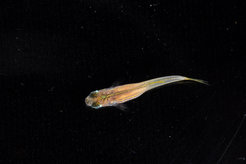Finding the beat of collective animal motion
Virtual Reality experiments have illuminated the rhythmic glue that could keep animals moving in synchrony
Across nature, animals from swarming insects to herding mammals can organize into seemingly choreographed motion. Over the last two decades, scientists have discovered that these coordinated movements arise from each animal following simple rules about where their neighbors are located. Now, scientists studying zebrafish have shown that neighbors might also be moving to the same beat. The team revealed that fish swimming in pairs took turns to move; and, they synchronized the timing of these movements in a two-way process known as reciprocity. Then, in virtual reality experiments, the team could confirm that reciprocity was key to driving collective motion: by implementing this rhythmic rule, they could recreate natural schooling behavior in fish and virtual conspecifics. The study published in Nature Communications was led by scientists from the Cluster of Excellence Collective Behaviour at the University of Konstanz and the Max Planck Institute of Animal Behavior in Germany (MPI-AB).

The results provide further mechanistic detail to our understanding of how animals self-organize into moving collectives. “We show that it takes two fish to tango,” says first author Guy Amichay, who conducted the work while a doctoral student at MPI-AB. “Fish are coordinating the timing of their movements with that of their neighbor, and vice versa. This two-way rhythmic coupling is an important, but overlooked, force that binds animals in motion.”
The synchrony of the swarm
Animals moving in synchrony are the most conspicuous examples of collective behavior in nature; yet many natural collectives synchronize not in space, but in time—fireflies synchronize their flashes, neurons synchronize their firing, and humans in concert halls synchronize the rhythm of clapping.
Amichay and the team were interested in the intersection of the two; they were curious to see what rhythmic synchrony might exist in animal movement. “There’s more rhythm to animal movement than you might expect,” says Amichay, who is now a postdoctoral researcher at Northwestern University, USA. “In the real world most fish don’t swim at fixed speeds, they oscillate.”
Using pairs of zebrafish as a study system, Amichay analyzed their swimming to describe the precise pattern of motion. He found that fish, although moving together, did not swim at the same time. Rather they alternated such that one moved, then the other moved, “like two legs walking,” he says.
The team then looked into how fish managed to alternate. They generated a computational model with a simple rule of thumb: double the delay of your neighbor.
Synchronized swimming
The rule of reciprocity
The next step was to test this model computationally, or in silico. They set one agent to beat with fixed movement bouts, like a metronome. The other agent responded to the first by implementing the ‘double the delay’ rhythmic rule. But in this one-way interaction, the agents did not move in the alternating pattern seen in real fish. When both agents responded to each other, however, they reproduced the natural alternation pattern. “This was the first indication that reciprocity was crucial,” says Amichay.
But reproducing natural behavior in a computer was not where the study ended. The team turned to virtual reality to confirm that the principle they uncovered would also work in real fish. “Virtual reality is a revolutionary tool in animal behavior studies because it allows us to circumvent the curse of causality,” says Iain Couzin, a Speaker at the Cluster of Excellence Collective Behaviour at the University of Konstanz and a Director at MPI-AB.

In nature many traits are linked and so it is extremely difficult to pinpoint the cause of an animal’s behavior. But using virtual reality, Couzin says it is possible to “precisely perturb the system” to test the effect of a particular trait on an animal’s behavior.
A single fish was put into a virtual environment with a fish avatar. In some trials the avatar was set to swim like a metronome, ignoring the behavior of the real fish. In these trials the real fish did not swim in the natural alternating pattern with the avatar. But when the avatar was set to respond to the real fish, in a two-way reciprocal relationship, they recovered its natural alternating behavior.
Turn-taking partners
“It’s fascinating to see that reciprocity is driving this turn-taking behavior in swimming fish,” says co-author Máté Nagy, who leads the MTA-ELTE Collective Behavior Research Group at the Hungarian Academy of Sciences, “because it’s not always the case in biological oscillators.” Fireflies, for example, will synchronize even in one-way interactions.
“But for humans, reciprocity comes into play in almost anything we do in pairs, be it dance, or sport, or conversation,” says Nagy.
The team also provided evidence that fish that were coupled in the timing of movements had stronger social bonds. “In other words, if you and I are coupled, we are more attuned to each other,” says Nagy.
The authors say that this finding can drastically change how we understand who influences whom in animal groups. “We used to think that in a busy group, a fish could be influenced by any other member that it can see,” says Couzin. “Now, we see that the most salient bonds could be between partners that choose to rhythmically synchronize.”













